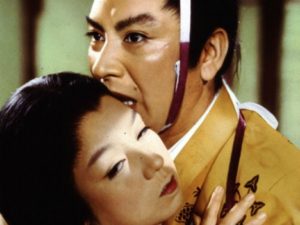Gate of Hell
Rating: *****
Origin: Japan, 1953
Director: Teinosuke Kinugasa
Source: Criterion Collection

This samurai tragedy is really more of a jidaigeki, a period costume drama, than a chambara, or swordplay movie, though there’s plenty of colorful action in the first third of its running time. Unlike most samurai films, which are usually set during the Shogunate of the 16th-19th centuries, this takes place in the earlier Heian period of the 12th century, when the relationship between the imperial noble class and the samurai warrior class was still evolving. During a military rebellion against the Court, Morito (Kazuo Hasegawa), a fierce fighter, sides with the samurai loyal to the Emperor, and in the chaos is assigned to conduct a diversion, escorting a lady impersonating the Empress in an apparent attempt to escape the rebel soldiers. He succeeds, but in the process is smitten with the beauty, poise, and courage of the lady, Kesa (Machiko Kyo), who performs the imposture. After the battle she disappears, and Morito doesn’t see her again until after the rebellion is put down, when he encounters her by chance, and his feelings are rekindled.
Peace restored, when the samurai who stayed loyal are being rewarded by Lord Kiyomori, Morito asks him for Lady Kesa’s hand, and only then learns that she’s already married to a noble of the Court. Morito, obsessed, vows to win her for himself regardless, and matters quickly go from bad to worse. Director Teinosuke Kinugasa’s pacing is masterful, ratcheting up the tension as the story marches toward its crushing end. This was one of Japan’s first big-budget color films, and even by today’s standards it’s drop-dead gorgeous, exquisite, a painting come to life. Kinugasa deliberately contrasts the serenity of nature with the violence of human emotions, but without judgment or sentimentality, allowing the characters and their actions to speak to the viewer for themselves. And all in eighty-six minutes, without a second wasted. What a treasure.